Meltdown & Spectre: Analyzing Performance Impacts on Intel's NUC7i7BNH
by Ganesh T S on March 23, 2018 4:15 PM EST- Posted in
- Systems
- Spectre
- Benchmarks
- Meltdown
Miscellaneous Benchmarks
CINEBENCH R15 is our benchmark of choice for 3D rendering. It provides three benchmark modes - OpenGL, single threaded and multi-threaded. This benchmark is largely unaffected by the patching. All the recorded numbers are within the margin of expected errors from one run to another.
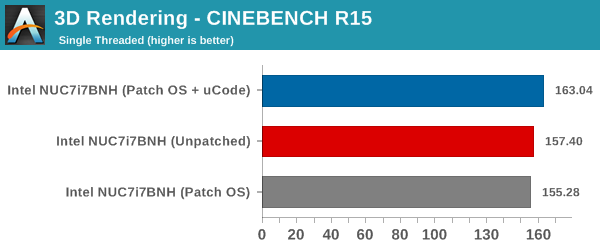
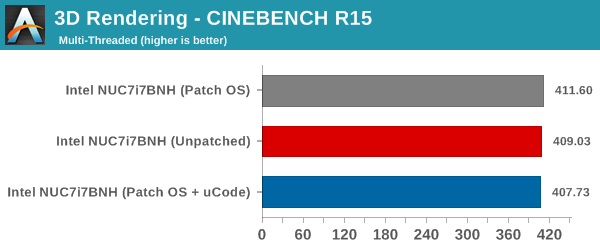
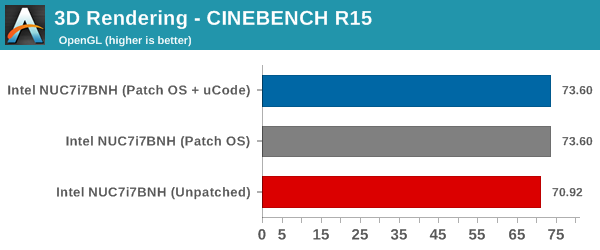
x264 v5.0 is another benchmark that is unaffected by the Meltdown and Spectre patches.
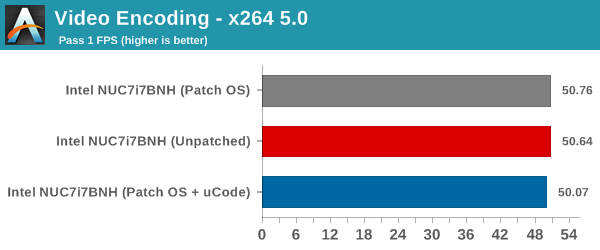
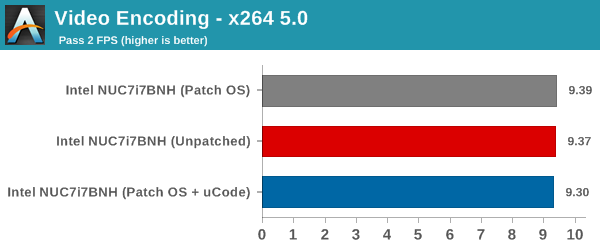
7-Zip is a very effective and efficient compression program, often beating out OpenCL accelerated commercial programs in benchmarks even while using just the CPU power. 7-Zip has a benchmarking program that provides tons of details regarding the underlying CPU's efficiency. In our benchmark suite, we are interested in the compression and decompression MIPS ratings when utilizing all the available threads. This benchmark also remains unaffected, with the results happening to be within the margin of error from run to run.
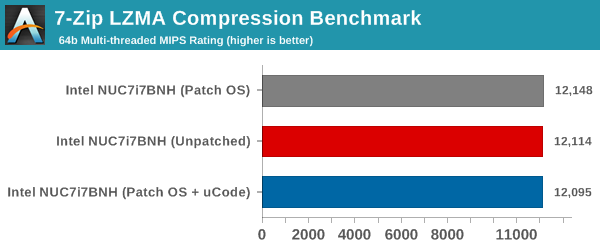
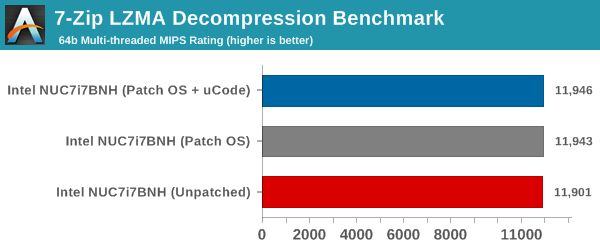
Agisoft PhotoScan is a commercial program that converts 2D images into 3D point maps, meshes and textures. The program designers sent us a command line version in order to evaluate the efficiency of various systems that go under our review scanner. The command line version has two benchmark modes, one using the CPU and the other using both the CPU and GPU (via OpenCL). We have been using an old version of the program with 50 photographs in our reviews till now. The updated benchmark (v1.3) now takes around 84 photographs and does four stages of computation:
- Stage 1: Align Photographs (capable of OpenCL acceleration)
- Stage 2: Build Point Cloud (capable of OpenCL acceleration)
- Stage 3: Build Mesh
- Stage 4: Build Textures
We record the time taken for each stage. Since various elements of the software are single threaded, others multithreaded, and some use GPUs, it is a very relevant benchmark from a media editing and content creation perspective.
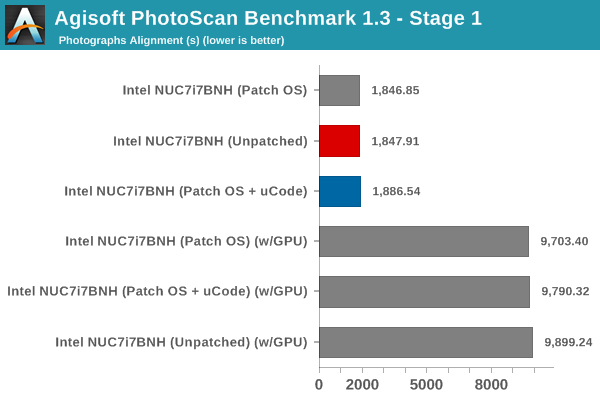
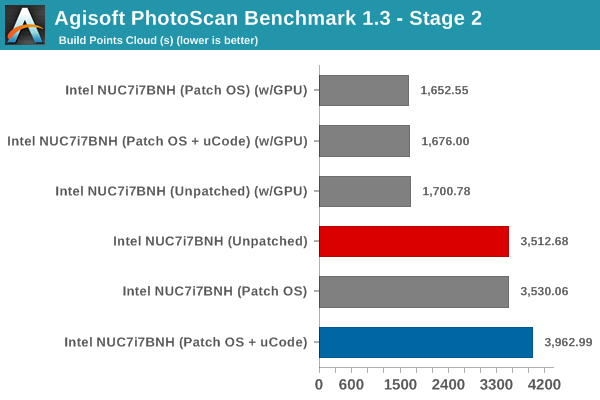
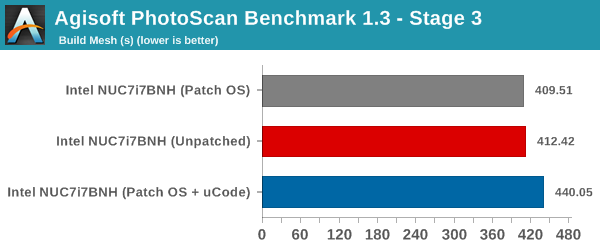
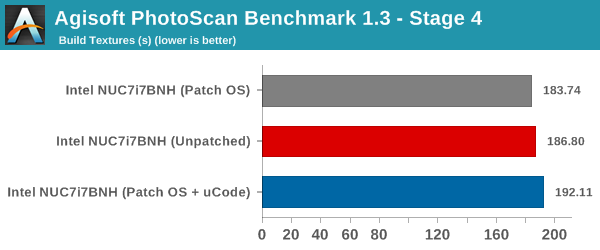
Since this is a real-world benchmark, we can see performance impacts in some of the stages. While the first and last ones do not have any significant deviation, stages 2 and 3 are worse off by around 12.8% and 6.8% respectively in the non-GPU case.
The benchmarks section wraps up with the new Dolphin Emulator (v5) benchmark mode results. This is again a test of the CPU capabilities, but, we don't see much impact on the performance from the patching. The bennchmark consistently took around 325 seconds in all three patching configurations.










83 Comments
View All Comments
chuychopsuey - Friday, March 23, 2018 - link
Wow! That's pretty significant. Looks like it takes you a generation or two backwards.Samus - Saturday, March 24, 2018 - link
The real damage comes for people with NVMe SSD's or other CPU-centric PCIe hardware. 29% performance drop...wow.III-V - Saturday, March 24, 2018 - link
On a single benchmark.You might need to see an optometrist.
Samus - Sunday, March 25, 2018 - link
Optometrist, no. Optimist, yes.umano - Sunday, March 25, 2018 - link
I want to be optimist, this is not a very powerful cpu "This significant performance loss is partly due to the NVMe drive performance now being CPU bound" so maybe on more powerful cpu this % will be lower... I hope solinuxgeex - Monday, March 26, 2018 - link
yes but people with high-end CPUs will tend to have even faster drives, or RAID, or Optane as a disk cache, and I've seen benchmarks where Optane performance dropped >40% on i9. Desktop users won't feel this very much but others who have been paying 300% more for 25% more performance for scale-up business logic are crying.iter - Monday, March 26, 2018 - link
Ultra high performance is only required in workstations. Workstations are used for important work. It is best to keep such systems offline. No need for antivirus, firewall, updating, patching and all that stuff that impedes performance and introduces downtime.The maxima among professionals is "if it works don't touch it". We are well past the point where it is worth keeping everything up to date with the latest versions. It's been a while since version updates were about making things better for the user, they are mostly about making things better for the big software corporations.
Use a separate low end system for internet. With nothing important on it.
PeachNCream - Monday, March 26, 2018 - link
I can't think of any situations where I've seen professional workstations that are intentionally kept offline and deprived of software updates. Perhaps that's something that would happen in a small business or SOHO where the end user is also her own IT support and might make such an odd decision, but as a client to a company using that sort of policy, I'd be concerned they were making a larger error of judgement in adhering to automotive or mechanical engineering wisdom of the 20th Century.iter - Monday, March 26, 2018 - link
That same wisdom that has resulted in countless security breaches and the privacy of billions of people violated.Thanks but no thanks. The "standards" are too low.
The lack of internet connectivity doesn't in any way impede dedicated support personnel from supporting. Those people are supposed to know their biz, not google about it.
The only error in judgement you should be concerned at the time is your own. A system that is dedicated to doing work has no job being connected to the internet. There is absolutely no good reason to update it as long as it operates property. The update will add no value, will only introduce downtime, and is likely to break stuff up.
PeachNCream - Monday, March 26, 2018 - link
Despite those strongly expressed thoughts, there are very few workstations that are running as stand-alone systems that don't get vendor software updates.